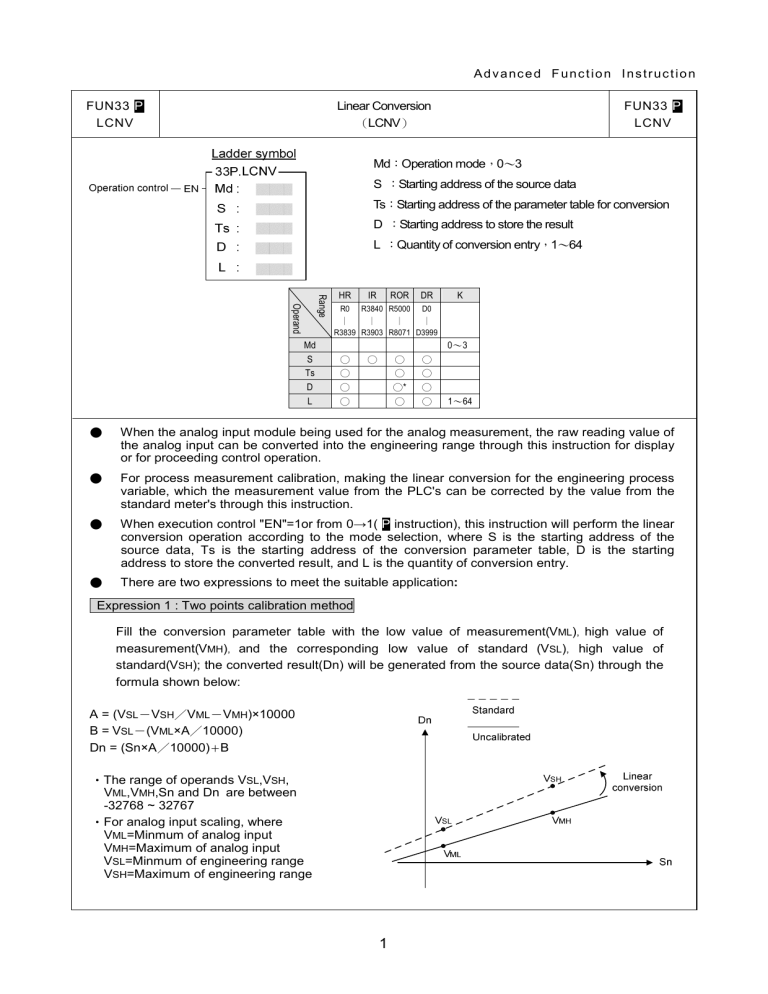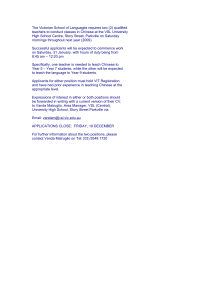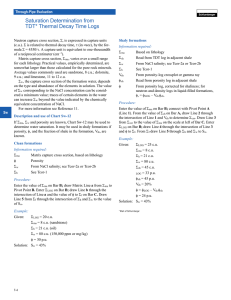
Advanced Function Instruction FUN33 P LCNV Linear Conversion (LCNV) FUN33 P LCNV Md:Operation mode,0~3 S :Starting address of the source data Ts:Starting address of the parameter table for conversion D :Starting address to store the result L :Quantity of conversion entry,1~64 Range Operand Md S Ts D L HR IR ROR DR K R0 R3840 R5000 D0 ∣ ∣ ∣ ∣ R3839 R3903 R8071 D3999 0~3 ○ ○ ○ ○ ○ ○ ○ ○* ○ ○ ○ ○ ○ 1~64 ● When the analog input module being used for the analog measurement, the raw reading value of the analog input can be converted into the engineering range through this instruction for display or for proceeding control operation. ● For process measurement calibration, making the linear conversion for the engineering process variable, which the measurement value from the PLC's can be corrected by the value from the standard meter's through this instruction. ● When execution control "EN"=1or from 0→1( P instruction), this instruction will perform the linear conversion operation according to the mode selection, where S is the starting address of the source data, Ts is the starting address of the conversion parameter table, D is the starting address to store the converted result, and L is the quantity of conversion entry. ● There are two expressions to meet the suitable application: Expression 1 : Two points calibration method Fill the conversion parameter table with the low value of measurement(VML), high value of measurement(VMH), and the corresponding low value of standard (VSL), high value of standard(VSH); the converted result(Dn) will be generated from the source data(Sn) through the formula shown below: A = (VSL-VSH/VML-VMH)×10000 B = VSL-(VML×A/10000) Dn = (Sn×A/10000)+B ‧The range of operands VSL,VSH, VML,VMH,Sn and Dn are between -32768 ~ 32767 ‧For analog input scaling, where VML=Minmum of analog input VMH=Maximum of analog input VSL=Minmum of engineering range VSH=Maximum of engineering range 1 Advanced Function Instruction FUN33 P LCNV Linear Conversion (LCNV) FUN33 P LCNV Expression 2 : Multiplicator+Offset method Fill the conversion parameter table with the values of multiplier(A), divisor(B) and offset(C); The converted result(Dn) will be generated from the source data(Sn) through the formula shown below: Dn =[(Sn×A)/B]+C The range of each operand as below: A = 1 ~ 65535 B = 1 ~ 65535 A B C = -32768 ~ 32767 Sn = 0 ~ 65535 Dn = -32768 ~ 32767 Description of operation mode : 1. When Md = 0, the linear conversion works by expression 1, and all source data share the same parameters VML、VMH、VSL and VSH for conversion. 2. When Md = 1, the linear conversion works by expression 1, and each source data has the independent corresponding parameters VML、VMH、VSL、VSH for conversion; if there are N entries of source data, the conversion parameter table should have N groups of VML、VMH、VSL、VSH for working, there are N×4 registers in the conversion parameter table. 3. When Md = 2, the linear conversion works by expression 2, and all source data share the same parameters A、B and C for conversion. 4. When Md = 3, the linear conversion works by expression 2, and each source data has the independent corresponding parameters A、B、C for conversion; if there are N entries of source data, the conversion parameter table should have N groups of A、B、C for working, there are N×3 registers in the conversion parameter table. 2 Advanced Function Instruction FUN33 P LCNV Linear Conversion (LCNV) FUN33 P LCNV Example program 1 : Mode 0 of linear conversion Description : When M0 = 1, it will perform the mode 0 operation of linear conversion, where R100 is the starting address of the source data, R1000 is the starting address of the table of the conversion parameters VML、VMH、VSL、VSH, the quantity is 6, and R2000~R2005 will store the converted results. Ts R1000 R1001 R1002 R1003 282 V ML 3530 V MH 260 V SL 3650 V SH S R100 R101 R102 R103 R104 R105 282 3530 1906 0 5000 -115 D Ö R2000 R2001 R2002 R2003 R2004 R2005 3 260 3650 1955 -34 5184 -154 Advanced Function Instruction FUN33 P LCNV Linear Conversion (LCNV) FUN33 P LCNV Example program 2 : Mode 1 of linear conversion Description : When M0 = 1, it will perform the mode 1 operation of linear conversion, where R100 is the starting address of the source data, R1000 is the starting address of the table of the conversion parameters VML、VMH、VSL、VSH, the quantity is 3, and R2000~R2002 will store the converted results. Ts R1000 R1001 R1002 282 V ML_0 3530 V MH_0 260 V SL_0 R1003 3650 V SH_0 R1004 -5 2 V ML_1 R1005 1208 V MH_1 R1006 -3 8 V SL_1 R1007 1101 V SH_1 R1008 235 V ML_2 R1009 4563 V MH_2 R1010 R1011 264 V SL_2 V SH_2 4588 S R100 R101 R102 282 1208 2399 D Ö R2000 R2001 R2002 4 260 1100 2426 Advanced Function Instruction FUN33 P LCNV Linear Conversion (LCNV) FUN33 P LCNV Example program 3 : Mode 2 of linear conversion Description : When M0 = 1, it will perform the mode 2 operation of linear conversion, where R100 is the starting address of the source data, R1000 is the starting address of the table of the conversion parameters A、B、C, the quantity is 6, and R2000~R2005 will store the converted results. Ts R1000 R1001 R1002 985 A 1000 B 22 C S R100 R101 R102 R103 R104 R105 1000 2345 3560 401 568 2680 D Ö R2000 R2001 R2002 R2003 R2004 R2005 5 1005 2329 3526 414 579 2659 Advanced Function Instruction FUN33 P LCNV Linear Conversion (LCNV) FUN33 P LCNV Example program 4 : Mode 3 of linear conversion Description : When M0 = 1, it will perform the mode 3 operation of linear conversion, where R100 is the starting address of the source data, R1000 is the starting address of the table of the conversion parameters A、B、C, the quantity is 4, and R2000~R2003 will store the converted results. Ts R1000 R1001 R1002 5000 A _0 16380 B _0 R1003 10000 A _1 R1004 16383 B _1 C _0 0 R1005 0 C _1 R1006 2200 A _2 R1007 16380 B _2 R1008 -20 0 C _2 R1009 1600 A _3 R1010 R1011 16383 B _3 -1 0 0 C _3 S R100 R101 R102 R103 8192 16383 8190 0 D Ö R2000 R2001 R2002 R2003 6 2500 10000 900 -1 0 0





